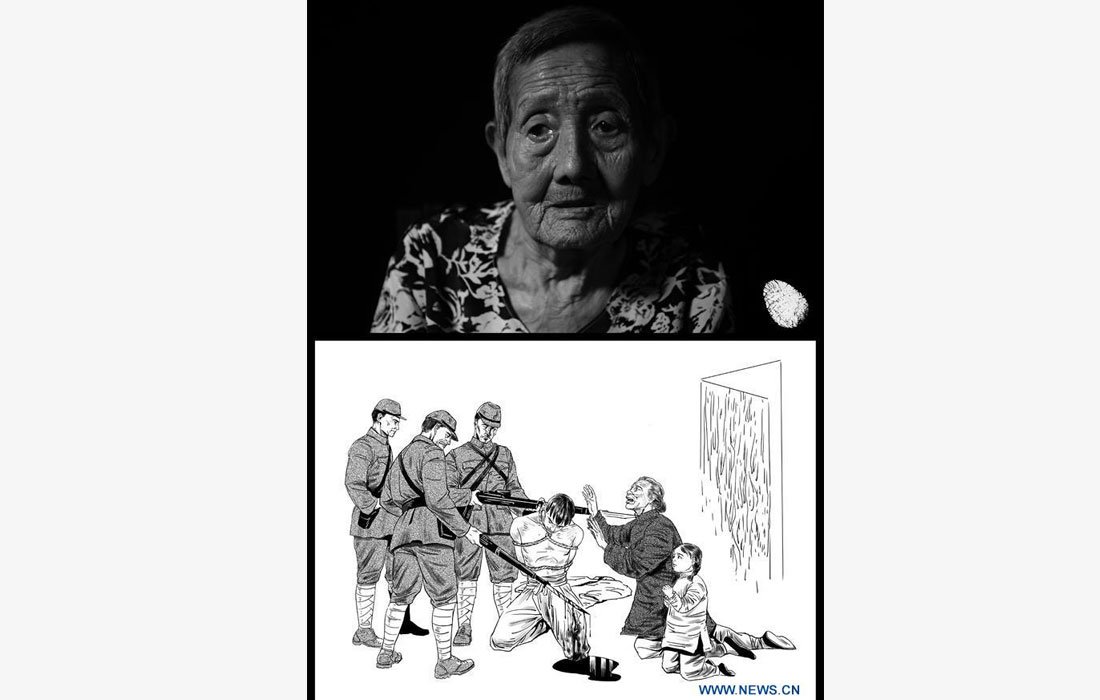
Illustrated story revives tragedy of Nanjing Massacre survivors
By Xinhua, Published: 2017-12-11 11:19:25
The combo picture shows the portrait, fingerprint of Zhang Lanying and illustrated story reviving her tragedy based on facts. Born on Dec. 6, 1929, Zhang is a survivor of Nanjing Massacre, a heinous crime committed by the Japanese militarists during World War II in 1937, in Nanjing, then capital of China. On the first day after Japanese troops entered Nanjing, three Japanese soldiers broke into her home, bound her elder brother Zhang Huaizhi and stabbed his thigh. Zhang and her mother dropped to their knees and begged piteously, brought Zhang Huaizhi back to life. The year 2017 marks the 80th anniversary of the Nanjing Massacre, in which more than 300,000 Chinese were killed by the Japanese invaders who occupied Nanjing on Dec. 13, 1937, marking the start of six weeks of destruction, pillage, rape and slaughter in the city. There are only less than 100 living survivors of the atrocity. Reporters from Xinhua spent many years to look for the survivors of Nanjing Massacre and record their current lives.Photo: Xinhua
[GalleryHights]
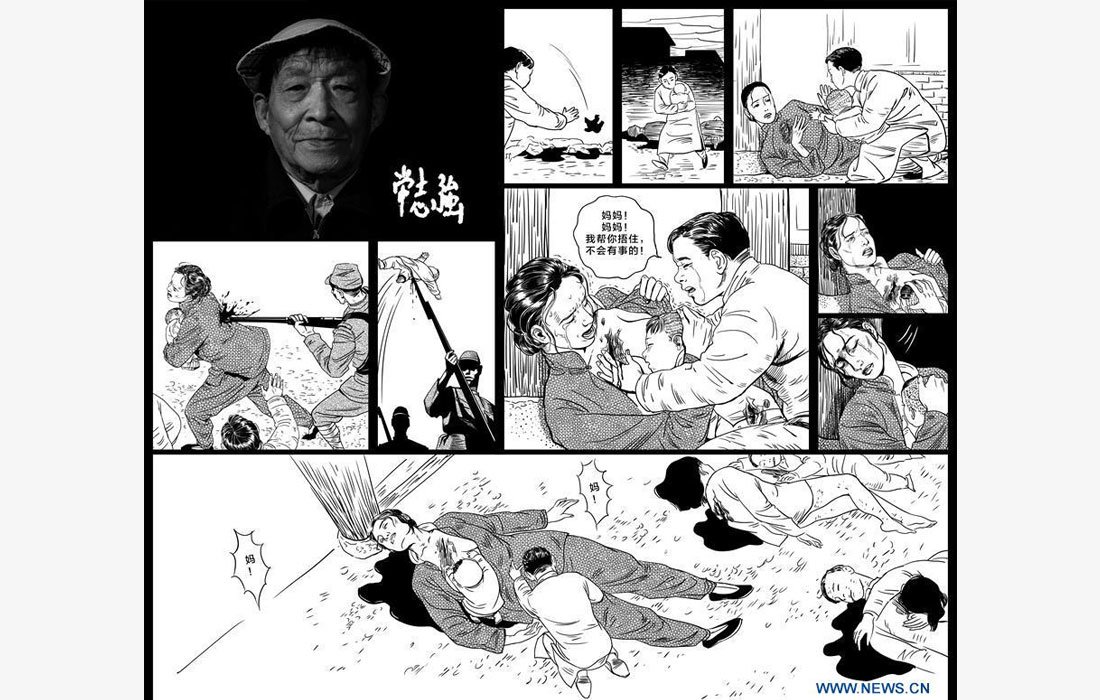 The combo picture shows the portrait, signature of Chang Zhiqiang and illustrated story reviving his tragedy based on facts. Born on Feb. 4, 1928, Chang is a survivor of Nanjing Massacre, a heinous crime committed by the Japanese militarists during World War II in 1937, in Nanjing, then capital of China. In December of 1937, then 9-year-old Chang witnessed his father and three younger brothers murdered by Japanese troops. His mother was stabbed to death, before dying she still tried to breed her youngest son. The youngest brother of Chang froze and perished not long after. Chang were greatly shocked, soon passed out, escaping death by a hair's breadth. The year 2017 marks the 80th anniversary of the Nanjing Massacre, in which more than 300,000 Chinese were killed by the Japanese invaders who occupied Nanjing on Dec. 13, 1937, marking the start of six weeks of destruction, pillage, rape and slaughter in the city. There are only less than 100 living survivors of the atrocity. Reporters from Xinhua spent many years to look for the survivors of Nanjing Massacre and record their current lives. Photo: Xinhua
The combo picture shows the portrait, signature of Chang Zhiqiang and illustrated story reviving his tragedy based on facts. Born on Feb. 4, 1928, Chang is a survivor of Nanjing Massacre, a heinous crime committed by the Japanese militarists during World War II in 1937, in Nanjing, then capital of China. In December of 1937, then 9-year-old Chang witnessed his father and three younger brothers murdered by Japanese troops. His mother was stabbed to death, before dying she still tried to breed her youngest son. The youngest brother of Chang froze and perished not long after. Chang were greatly shocked, soon passed out, escaping death by a hair's breadth. The year 2017 marks the 80th anniversary of the Nanjing Massacre, in which more than 300,000 Chinese were killed by the Japanese invaders who occupied Nanjing on Dec. 13, 1937, marking the start of six weeks of destruction, pillage, rape and slaughter in the city. There are only less than 100 living survivors of the atrocity. Reporters from Xinhua spent many years to look for the survivors of Nanjing Massacre and record their current lives. Photo: Xinhua 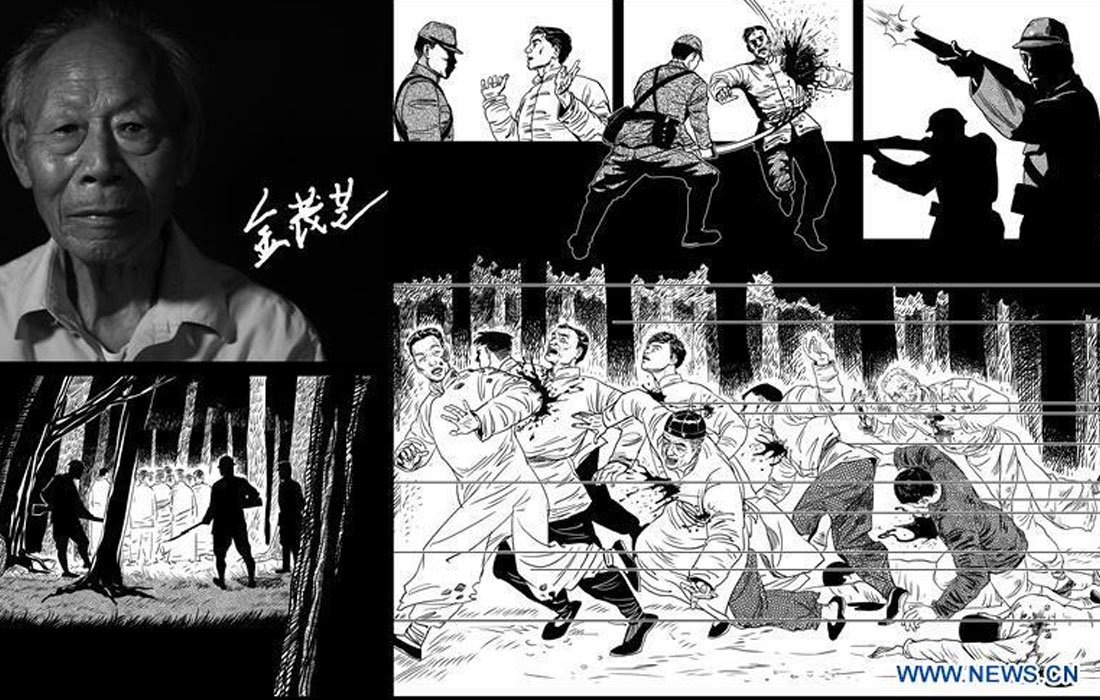 The combo picture shows the portrait, signature of Jin Maozhi and illustrated story reviving his tragedy based on facts. Born on Feb. 2, 1928, Jin is a survivor of Nanjing Massacre, a heinous crime committed by the Japanese militarists during World War II in 1937, in Nanjing, then capital of China. In the winter of 1937, Jin's father Jin Zhaokun and a dozen of male villagers were gathered at a small reservoir to be slaughtered. Jin's father lost one arm while arguing with the Japanese soldiers before his death. More unarmed civilians were butchered, Jin saw with his own eyes repeatedly in that winter. The year 2017 marks the 80th anniversary of the Nanjing Massacre, in which more than 300,000 Chinese were killed by the Japanese invaders who occupied Nanjing on Dec. 13, 1937, marking the start of six weeks of destruction, pillage, rape and slaughter in the city. There are only less than 100 living survivors of the atrocity. Reporters from Xinhua spent many years to look for the survivors of Nanjing Massacre and record their current lives. Photo: Xinhua
The combo picture shows the portrait, signature of Jin Maozhi and illustrated story reviving his tragedy based on facts. Born on Feb. 2, 1928, Jin is a survivor of Nanjing Massacre, a heinous crime committed by the Japanese militarists during World War II in 1937, in Nanjing, then capital of China. In the winter of 1937, Jin's father Jin Zhaokun and a dozen of male villagers were gathered at a small reservoir to be slaughtered. Jin's father lost one arm while arguing with the Japanese soldiers before his death. More unarmed civilians were butchered, Jin saw with his own eyes repeatedly in that winter. The year 2017 marks the 80th anniversary of the Nanjing Massacre, in which more than 300,000 Chinese were killed by the Japanese invaders who occupied Nanjing on Dec. 13, 1937, marking the start of six weeks of destruction, pillage, rape and slaughter in the city. There are only less than 100 living survivors of the atrocity. Reporters from Xinhua spent many years to look for the survivors of Nanjing Massacre and record their current lives. Photo: Xinhua 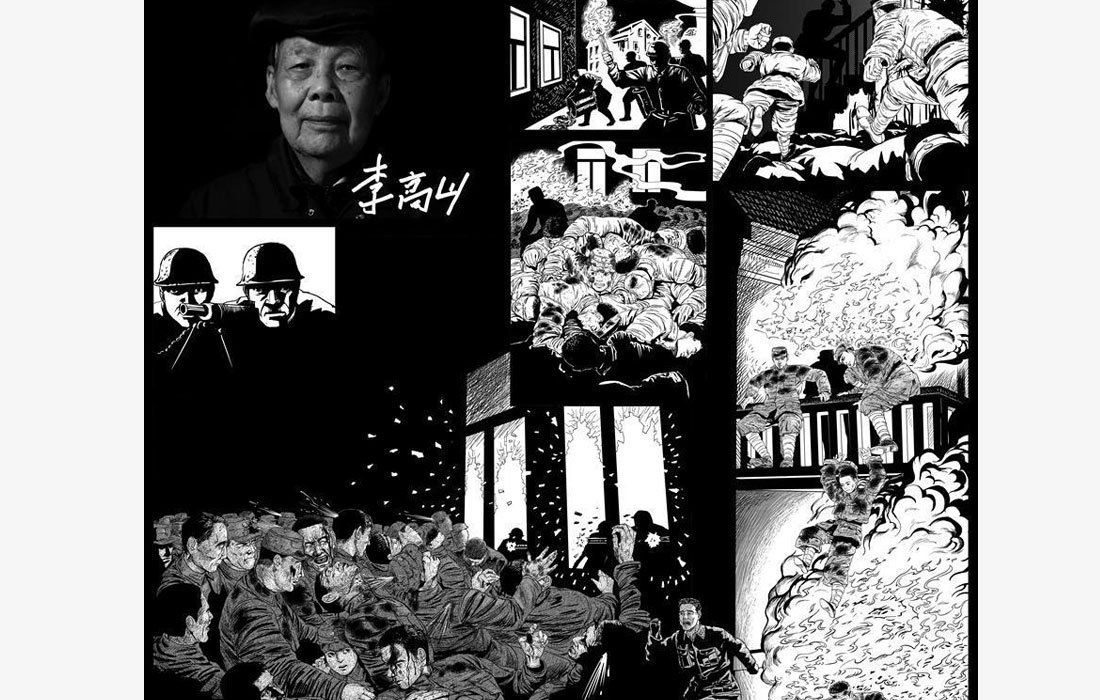 The combo picture shows the portrait, signature of Li Gaoshan and illustrated story reviving his tragedy based on facts. Born on Feb. 24, 1925, Li is a survivor of Nanjing Massacre, a heinous crime committed by the Japanese militarists during World War II in 1937, in Nanjing, then capital of China. In the winter of 1937, then 13-year old Li served as a soldier guarding Nanjing. After handing over his arms and surrendered, he and hundreds of his battle companions were escorted to enclosed houses, then confronting with wild machine gun blasting and massive fire. Almost every bare-handed prisoner of war there died on the spot, most fortunately, Li survived thanks to his short stature. The year 2017 marks the 80th anniversary of the Nanjing Massacre, in which more than 300,000 Chinese were killed by the Japanese invaders who occupied Nanjing on Dec. 13, 1937, marking the start of six weeks of destruction, pillage, rape and slaughter in the city. There are only less than 100 living survivors of the atrocity. Reporters from Xinhua spent many years to look for the survivors of Nanjing Massacre and record their current lives. Photo: Xinhua
The combo picture shows the portrait, signature of Li Gaoshan and illustrated story reviving his tragedy based on facts. Born on Feb. 24, 1925, Li is a survivor of Nanjing Massacre, a heinous crime committed by the Japanese militarists during World War II in 1937, in Nanjing, then capital of China. In the winter of 1937, then 13-year old Li served as a soldier guarding Nanjing. After handing over his arms and surrendered, he and hundreds of his battle companions were escorted to enclosed houses, then confronting with wild machine gun blasting and massive fire. Almost every bare-handed prisoner of war there died on the spot, most fortunately, Li survived thanks to his short stature. The year 2017 marks the 80th anniversary of the Nanjing Massacre, in which more than 300,000 Chinese were killed by the Japanese invaders who occupied Nanjing on Dec. 13, 1937, marking the start of six weeks of destruction, pillage, rape and slaughter in the city. There are only less than 100 living survivors of the atrocity. Reporters from Xinhua spent many years to look for the survivors of Nanjing Massacre and record their current lives. Photo: Xinhua 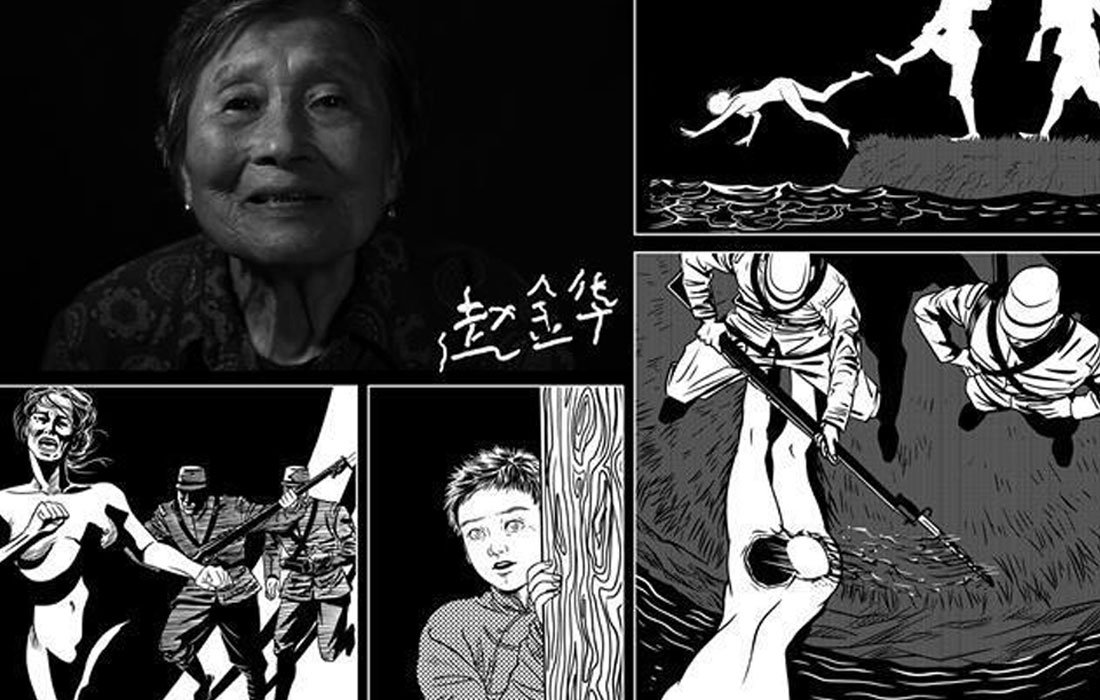 The combo picture shows the portrait, signature of Zhao Jinhua and illustrated story reviving her tragedy based on facts. Born on Dec. 22, 1924, Zhao is a survivor of Nanjing Massacre, a heinous crime committed by the Japanese militarists during World War II in 1937, in Nanjing, then capital of China. In December of 1937, then 13-year old Zhao witnessed the sister of her grandma being raped and drowned into a river with the lower part of the body mutilated. The year 2017 marks the 80th anniversary of the Nanjing Massacre, in which more than 300,000 Chinese were killed by the Japanese invaders who occupied Nanjing on Dec. 13, 1937, marking the start of six weeks of destruction, pillage, rape and slaughter in the city. There are only less than 100 living survivors of the atrocity. Reporters from Xinhua spent many years to look for the survivors of Nanjing Massacre and record their current lives.Photo: Xinhua
The combo picture shows the portrait, signature of Zhao Jinhua and illustrated story reviving her tragedy based on facts. Born on Dec. 22, 1924, Zhao is a survivor of Nanjing Massacre, a heinous crime committed by the Japanese militarists during World War II in 1937, in Nanjing, then capital of China. In December of 1937, then 13-year old Zhao witnessed the sister of her grandma being raped and drowned into a river with the lower part of the body mutilated. The year 2017 marks the 80th anniversary of the Nanjing Massacre, in which more than 300,000 Chinese were killed by the Japanese invaders who occupied Nanjing on Dec. 13, 1937, marking the start of six weeks of destruction, pillage, rape and slaughter in the city. There are only less than 100 living survivors of the atrocity. Reporters from Xinhua spent many years to look for the survivors of Nanjing Massacre and record their current lives.Photo: Xinhua








